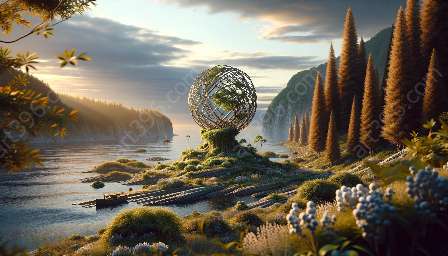Environmental art serves as a powerful medium for raising awareness and promoting the preservation of natural habitats. It provides a platform for artists to express their concerns about environmental issues and advocate for the conservation of biodiversity. When multimedia technology is integrated into environmental art, it expands the possibilities for engaging audiences and conveying important messages about the need to protect natural habitats.
The Impact of Multimedia in Environmental Art
Multimedia technology encompasses a wide range of tools and techniques, including digital media, interactive installations, virtual reality, and augmented reality. These innovative tools enable artists to create immersive experiences that captivate viewers and encourage them to reflect on the beauty and fragility of natural ecosystems. By integrating multimedia elements such as soundscapes, video projections, and interactive displays, environmental artists can evoke emotional responses and provoke meaningful dialogue about the impact of human activities on the environment.
Enhancing Awareness and Understanding
Through multimedia technology, environmental artists can convey complex environmental concepts in accessible and compelling ways. For instance, interactive installations can simulate the effects of climate change on various ecosystems, allowing viewers to experience the consequences of environmental degradation firsthand. These immersive experiences foster empathy and deepen understanding, prompting individuals to take action in support of conservation efforts.
Engaging Diverse Audiences
One of the key strengths of multimedia technology in environmental art lies in its ability to reach diverse audiences. Digital platforms and interactive exhibits can attract people of all ages and backgrounds, making environmental art more inclusive and impactful. By leveraging social media, virtual tours, and digital storytelling, artists can extend the reach of their work beyond traditional art spaces and engage global audiences in discussions about the preservation of natural habitats.
Preservation Through Collaborative Initiatives
Incorporating multimedia technology into environmental art can also catalyze collaborative initiatives aimed at preserving natural habitats. Through interactive mapping, data visualization, and citizen science projects, artists and conservation organizations can foster partnerships that monitor, protect, and restore ecosystems. These collaborative efforts harness the power of multimedia to gather and disseminate environmental data, mobilize communities, and advocate for policy changes that prioritize the conservation of biodiversity.
Insights from Environmental Artists
Environmental artists who integrate multimedia technology into their practice often emphasize the importance of fostering a sense of connection between viewers and the natural world. The use of multimedia has enabled artists to capture the intricate beauty of ecosystems, from the depths of oceans to the heights of forests, and present them in ways that resonate with audiences on a profound level.
Case Studies and Innovations
Several notable examples illustrate the impact of multimedia technology on the preservation of natural habitats in environmental art. From large-scale multimedia installations that transform urban landscapes into immersive natural environments to community-driven projects that use digital storytelling to highlight local conservation efforts, these case studies showcase the diverse and dynamic ways in which multimedia enhances environmental art's role in advocating for the protection of natural habitats.
Empowering Action and Advocacy
Ultimately, the integration of multimedia technology in environmental art empowers individuals to become advocates for the preservation of natural habitats. By fostering emotional connections and providing tangible insights into the challenges facing ecosystems, multimedia-enhanced environmental art inspires viewers to take meaningful actions to support conservation initiatives, promote sustainable practices, and amplify the voices of environmental stewards.
Conclusion
Multimedia technology and environmental art are intricately connected in their shared goal of preserving natural habitats. Through engaging storytelling, immersive experiences, and collaborative initiatives, multimedia enhances the impact of environmental art, fostering a deeper understanding of environmental issues and inspiring action to protect the planet's precious ecosystems.

